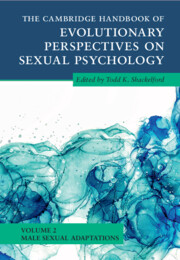Book contents
- The Cambridge Handbook of Evolutionary Perspectives on Sexual Psychology
- The Cambridge Handbook of Evolutionary Perspectives on Sexual Psychology
- Copyright page
- Contents
- Contributors
- Preface
- Part I Precopulatory Adaptations
- Part II Copulatory Adaptations
- 8 Sexual Fantasy
- 9 Ejaculation Latency
- 10 Copulatory Thrusting in Males
- 11 Men’s Provisioning of Oral Sex
- 12 Inducing Female Orgasm
- 13 Copulatory Urgency
- Part III Postcopulatory Adaptations
- Index
- References
8 - Sexual Fantasy
from Part II - Copulatory Adaptations
Published online by Cambridge University Press: 30 June 2022
- The Cambridge Handbook of Evolutionary Perspectives on Sexual Psychology
- The Cambridge Handbook of Evolutionary Perspectives on Sexual Psychology
- Copyright page
- Contents
- Contributors
- Preface
- Part I Precopulatory Adaptations
- Part II Copulatory Adaptations
- 8 Sexual Fantasy
- 9 Ejaculation Latency
- 10 Copulatory Thrusting in Males
- 11 Men’s Provisioning of Oral Sex
- 12 Inducing Female Orgasm
- 13 Copulatory Urgency
- Part III Postcopulatory Adaptations
- Index
- References
Summary
The main purpose of this chapter is to review the recent literature on male sexual fantasies. Topics that are analysed include sexual fantasies’ definitions and functions; methodological issues related to the disparate measures used across studies; the distinction between fantasies, interests/desires, and experiences; how general and unusual fantasies are developed; prevalence rates and the multidimensional content of fantasies, with highlights on gender, sexual orientation, and personality differences; and, finally, fantasies’ role in sexual offending. Overall, sexual fantasies are pervasive across the general population and, for the most part, they reflect evolutionary perspectives on psychology. As sexual fantasies can be used to increase sexual arousal in people that suffer from dysfunctions and to foster more positive romantic feelings towards a partner, they are important in clinical treatment and marital therapy settings. Moreover, they constitute a central component in the treatment of people convicted of sexual offenses that are at a high risk of recidivism. Therefore, it is essential to understand fantasies’ role in human sexuality and behaviour.
- Type
- Chapter
- Information
- Publisher: Cambridge University PressPrint publication year: 2022
References
- 2
- Cited by

